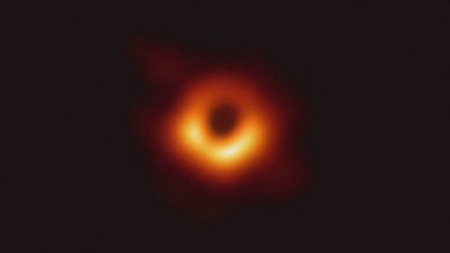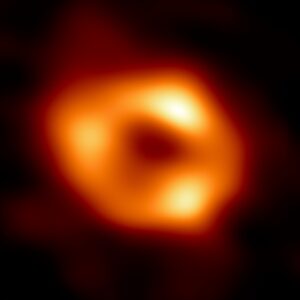Black Hole secrets have been unraveled by telescopic instruments. International astronomers have photographed a black hole—again. This one is in our own galaxy, right at the heart of the Milky Way. This historic accomplishment is big news this month.
Unbelievably, this accomplishment shatters all previous images of the black hole in the Milky Way. They were science fiction. However recently, scientists obtained the first real image of the black hole at the center of the Milky Way Galaxy. This discovery follows the 2019 first image of a faraway black hole. Read on to find out more about the images of both black holes.
Astronomers photographed both blackholes with a group of global telescopes at various locations around the world. They are known as the Event Horizon Telescope group. As their name suggests, they transform the globe into one big observatory through communication and data-sharing.
You might have only heard the general news of the photograph of the black hole at the center of our universe. our event briefly.
ER Optics Brings You Details of a Discovery Update

Behold an example of the Imaginary Science Fiction Images of Yesterday. Now we have real pictures of black holes.
ER Precision Optics now updates you on the significant photography of the black hole at the heart of our universe. Be aware we would not be seeing discoveries such as this without the kind of technology brought to you by companies such as ours.
At this point, let us quickly explain our interest in outer space scientific discovery. “Silicon wafers are the heart of modern technology.” Without them, you could not have semiconductors. And we know these semiconductors are the basic key to insturments of scientific discovery. Without them, the Event Horizon Telescopes group could not have coordinated both telescopes and communications to take these amazing photographs.
Additionally, we would remind you that: “ER Precision Optics creates silicon crystals to many precise specifications.” And the purity of our process brings you “optical grade as well as solar grade CZ grown material.” Without precision optical grade lenses, telescopes around the world would be blind and infrared photography in outer space would be dark.
A Show-stopping Image of Light and Dark
Now, let’s investigate the new image of the black hole at the center of our Galaxy. The image looks like a bright ring in darkness. This shape is formed as “light bends in the intense gravity around a black hole…”
You might like a quick definition at this point. What is a black hole, anyway? According to the experts, “Black holes are objects with an intense gravitational pull so strong that not even beams of light, the fastest things in the universe, can escape.”
It Took an Array of Telescopes with Specialized Optics to Photograph a Black Hole
The black hole certainly merited the much-published adjective, “supermassive.” And this black hole is not just any randomly found black hole. It is at the heart of our own Milky Way galaxy.
The image was taken by the Event Horizon Telescope Collaboration. EHT is a group of telescopes that literally ring the earth. Thus, many telescopes in many nations cooperated at the same moment to gather this information.
Now we have amazing firsthand evidence of the existence and the appearance of black holes.The new photographic evidence also brings us hints about the functions of gigantic black holes. Likewise, the portrait of a black hole confirms the theories of many scientists and astronomers, including Albert Einstein.
Astronomers are now justified in affirming their suspicion that such a black hole indeed does exist at the center of most galaxies. (See below to discover why they feel justified.)
Unifying Optics: Seeing Earth as One Giant Telescope

Captured by the Event Horizon Telescope in 2019, we see the M87* black hole, the first image of a far away black hole. Image credit: Event Horizon Telescope Collaboration
Actually, this is the second time the astronomers of the Event Horizon Telescope network have photographed a black hole. Astronomers photographed the first one at the center of a different galaxy with the lackluster name of Messier 87 or M87*. EHT publicly revealed that photo, shown above, in 2019.
Keep in mind, that many observatories around the world captured the black hole images by working as a single enormous radio telescope. That in itself made capturing the image a huge challenge in coordination, timing and communication.
An Optics Back Story for Sagittarius A* and Messier 87’s Image
Historically, “In 2017, EHT observed two supermassive black holes: the one called M87* and one in our own Milky Way galaxy. They named the black hole at the center of our Milky Way “Sagittarius,” which is also abbreviated as Sgr A*…” As we stated, they revealed the image of M87* in 2019. However, it took three more painstaking years of research and photography to create the image of Sgr A, in our own galaxy. Read on to find out why.
After three years of meticulous analysis, the collaboration finally released the recent blockbuster Sgr A* image. “This is what we wanted to deliver on all along,” says EHT researcher Ziri Younsi at University College London. And he added, “This is what our black hole looks like.”

This is the new image of the black hole at the center of the Milky Way, Sagittarius A. Image credit: Event Horizon Telescope Collaboration
Then he explained, “Black holes don’t emit any light, so the image shows the black hole’s silhouette…” He continued his poetic yet scientific description. We see the silhouette against a glowing background of hot plasma swirling around and being pulled into Sagittarius A*.”
Time, Space, Optics, and Photography
He added, “That process occurs much more quickly with this black hole than with M87*. This is one reason why the new image took so much longer to produce. “ He further noted that “M87* is one of the largest known black holes in the universe, more than 1000 times the mass of Sgr A* in the Milky Way.” That gravity well is 6.5 billion times more massive than our star, Sol, the sun.
Thus, scientists have calculated that plasma circling M87* requires weeks or days to complete its orbit.
Two Black Holes: So Similar Yet So Different
Unlike M87*, it takes only a few minutes for hot plasma to circle our own Milky Way black hole, Sagittarius A*.Therefore, the brightness and patterns of the gas around Sgr A* changed rapidly, even as all the EHT telescopes were trying to make an image. Researcher, Chi-Kwan Chan at the University remarked that trying to photograph it was “a bit like trying to take a clear picture of a puppy quickly chasing its tail…”
A Universe of Challenges for Photographing Sgr A*
You might not realize it, but earth sits towards the edge of the milky Way. Thus, starlight, dust, and gas kept obscuring the astronomers’ view of the black hole. To create the ultimate image, they “aggregated many snapshots taken over the course of several nights…” That was a vast amount of data, so they used a supercomputer to process it.
Terrific Take-Aways from Our New Image of Sgr A*

Black Holes, Planets, Suns, and Galaxies Are Far Away. But, We Don’t Have to Go There to Study Them… Technology Can Be Our Tool.
The image highly resembles the 2019 image of M87*. Scientist Sera Markoff, at the University of Amsterdam, remarked on the similarities. “We have two completely different types of galaxies and two very different black hole masses…”
Then she observed, “But close to the edge of these black holes they look amazingly similar…” She then made two brilliant conclusions:
- Markoff declared, “This tells us that [Albert Einstein’s] general relativity governs these objects up close…”
- And she formulated, that the “Differences we see further away must be due to differences in the material that surrounds the black holes.”
Another scientist concurred, saying, “One of the things which surprises me personally was just how similar these images are to what theory predicts…” He added with a hint of wit, “Einstein’s doing well, again, and for people who have all their other theories of what gravity could be it might be a little disappointing.”
A Philosophical Conclusion from the New Image
Of course, the scientific data from this single study of the black hole at the heart of our Milky Way is rich. The data will doubtless occupy dozens of scientists for at least a decade.
However, we also see history and humanity in the cooperation of 13 different telescopes. The telescopes are housed in scientific observatories from different cultures, institutions, and governments. However, they came together in unity. Only by working together could they share the data and create a single image of the heart of our home galaxy.
We at ER Precision Optics believe that kind of cooperation and dedication is pretty amazing. In fact, it’s almost as rare as a black hole. Thus we send hearty congratulations to the Event Horizon Telescope collaboration.


